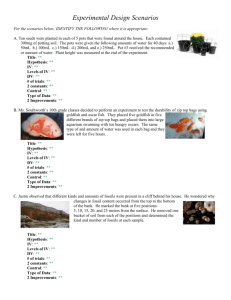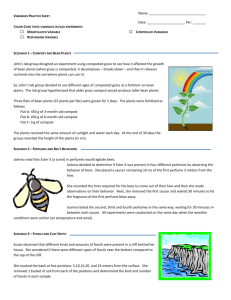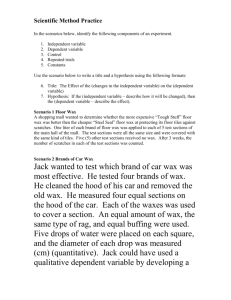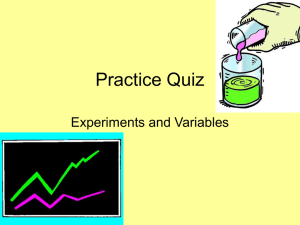Experiment Scenarios
advertisement
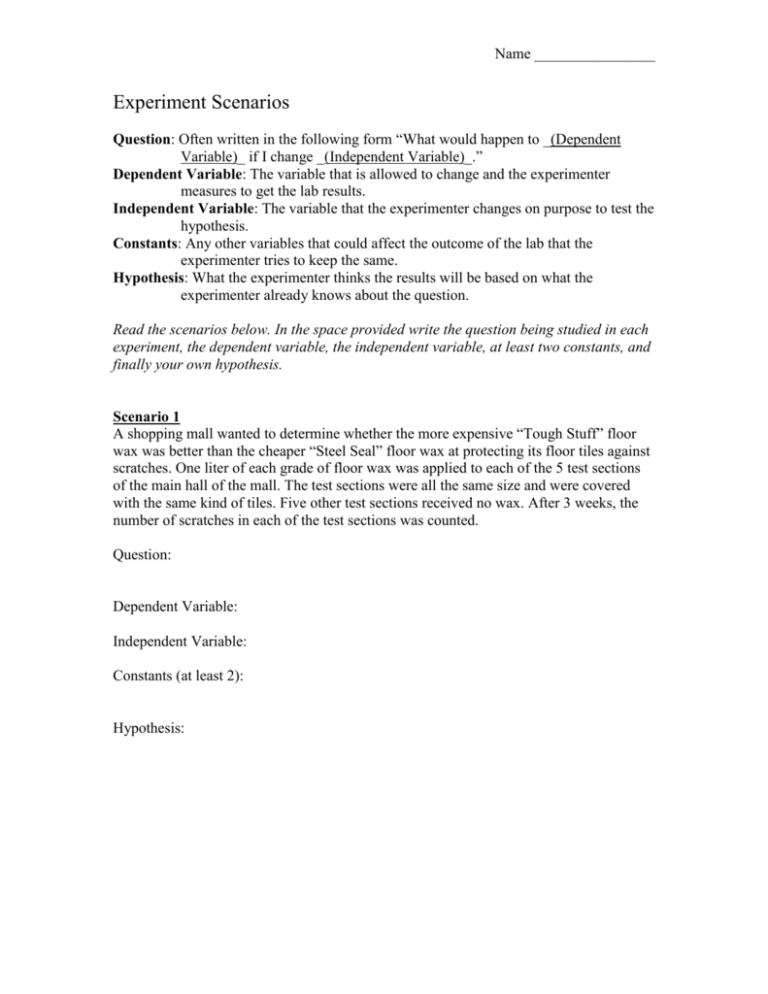
Name ________________ Experiment Scenarios Question: Often written in the following form “What would happen to _(Dependent Variable)_ if I change _(Independent Variable)_.” Dependent Variable: The variable that is allowed to change and the experimenter measures to get the lab results. Independent Variable: The variable that the experimenter changes on purpose to test the hypothesis. Constants: Any other variables that could affect the outcome of the lab that the experimenter tries to keep the same. Hypothesis: What the experimenter thinks the results will be based on what the experimenter already knows about the question. Read the scenarios below. In the space provided write the question being studied in each experiment, the dependent variable, the independent variable, at least two constants, and finally your own hypothesis. Scenario 1 A shopping mall wanted to determine whether the more expensive “Tough Stuff” floor wax was better than the cheaper “Steel Seal” floor wax at protecting its floor tiles against scratches. One liter of each grade of floor wax was applied to each of the 5 test sections of the main hall of the mall. The test sections were all the same size and were covered with the same kind of tiles. Five other test sections received no wax. After 3 weeks, the number of scratches in each of the test sections was counted. Question: Dependent Variable: Independent Variable: Constants (at least 2): Hypothesis: Name ________________ Scenario 2 An experiment was done to discover the right amount of water to use on a plant. Ten seeds were planted in each of 5 pots found around the house that contained 500g of “Pete’s Potting Soil.” The pots were given the following amounts of distilled water each day for 40 days: Pot 1, 50ml; Pot 2, 100ml; Pot 3, 150ml; Pot 4, 200ml; Pot 5, 250ml. The height of each plant was measured at the end of the experiment. Question: Dependent Variable: Independent Variable: Constants (at least 2): Hypothesis: Scenario 3 Gloria wanted to find out if the color of food would affect whether kindergarten children would select it for lunch. She put food coloring in 4 identical bowls of mashed potatoes. The colors were red, green, yellow, and blue. Each child chose a scoop of potatoes of the color of their choice. Gloria did this experiment using 100 students. She recorded the number of students that chose each color. Question: Dependent Variable: Independent Variable: Constants (at least 2): Hypothesis: Name ________________ Scenario 4 Susie wondered if the height of the hole punched in the side of a quart-sized milk carton would affect how far from the container a liquid would spurt when the carton was full of the liquid. She used 4 identical cartons and punched the same size hole in each. The hole was placed at a different height on one side of each of the containers. The heights of the holes were 5, 10, 15, and 20cm from the base of the carton. She put her finger over the hole and filled carton to a height of 25cm with liquid. When each carton was filled, she placed it in the sink and removed her finger. Susie measured how far away from the carton’s base the liquid had squirted when it hit the bottom of the sink. Question: Dependent Variable: Independent Variable: Constants (at least 2): Hypothesis: Scenario 5 Sandy heard that plants compete for space. She decided to test this idea. She bought a mixture of flower seeds and some potting soil. Into each of 5 plastic cups she put the same amount of soil. In the first cup she planted 2 seeds, in the second cup she planted 4 seeds, in the third cup 8 seeds, and in the fourth cup she planted 16 seeds. In the last cup she planted 32 seeds. After 25 days, she determined which set of plants looked the best. Question: Dependent Variable: Independent Variable: Constants (at least 2): Hypothesis: Name ________________ Scenario 6 Ester became interested in insulation while her parent’s new house was being built. She decided to determine which insulation transferred the least heat. She filled each of 5 jars half-full with water. She sealed each jar with a plastic lid. Then she wrapped each jar with a different kind of insulation. She put the jars outside in the direct sunlight. Later, she measured the temperature of the water in each jar. Question: Dependent Variable: Independent Variable: Constants (at least 2): Hypothesis: Scenario 7 After studying about recycling, members of John’s biology class investigated the effect of various recycled products on plant growth. John’s lab group compared the effect of different aged grass compost on bean plants. Because decomposition is necessary for the release of nutrients, the group hypothesized that older grass compost would produce taller bean plants. Three flats of bean plants were grown for five days. The plants were then fertilized as follows: (a) Flat A: 450g of 3 month old compost, (b) Flat B: 450 g of 6 month old compost, (c) Flat C: 0g compost. The plants received the same amount of sunlight and water each day. At the end of 30 days the group recorded the height of the plants (cm). Question: Dependent Variable: Independent Variable: Constants (at least 2): Hypothesis:

